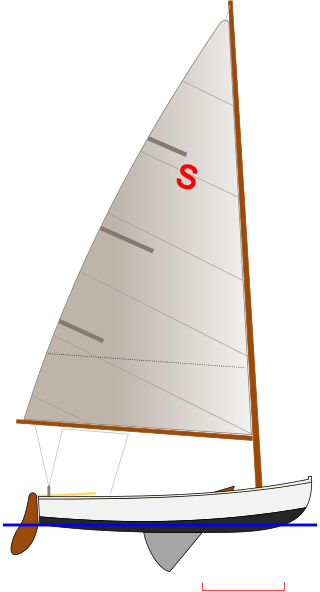
The Thistle is an American planing sailing dinghy that was designed by Sandy Douglass as a one-design racer and first built in 1945.

The Lightning is an American sailing dinghy that was designed by Olin Stephens of Sparkman & Stephens, as a one-design racer and first built in 1938.

The Snipe is an American sailing dinghy that was designed by William F. Crosby as a one design racer and first built in 1931.
The Comet, sometimes called the Comet OD or Comet One-Design, is an American sailing dinghy that was designed by C. Lowndes Johnson as a one-design racer and first built in 1932. The design has evolved over time via modifications.

The Jet 14 is an American sailing dinghy that was designed by Howard Siddons as a one-design racer and first built in 1952.

The Lido 14 is an American sailing dinghy that was designed by Barney Lehman and William D. Schock and first built in 1958.
The Rhodes 19 is an American trailerable day sailer or sailing dinghy, that was designed by Philip Rhodes as a one-design racer and first built in 1958.

The Penguin is an American sailing dinghy that was designed by Philip Rhodes in 1933 as a one design racer for frostbite racing on the US east coast and first built in 1939.

The Kite is an American sailboat that was designed by Carter Pyle as a one design racer and first built in 1965.

The Snowbird is an American sailboat that was initially designed by Willis Reid as a one design racer and first built in 1921. The boat was re-designed by Edson B. Schock in the 1940s and it became a popular junior class.
The Interclub Dinghy is an American sailing dinghy that was designed by Sparkman & Stephens as a one-design racer and first built in 1946. It is sailed in frostbite racing on the US east coast, particularly on Long Island Sound. Frostbite races are the series held after the normal sailing season is finished.
The Capri Cyclone, also referred to as the Cyclone 13 or just the Cyclone, is an American sailing dinghy that was designed by Frank V. Butler as a one-design racer and first built in 1970.
The Cheshire 14 is an American catamaran sailing dinghy that was designed by Frank Meldau as a racer and first built in 1962.
The Designers Choice is an American sailing dinghy that was designed by Sparkman & Stephens as a sail training and racing boat and first built in 1978. It was Sparkman & Stephens' design #2349.
The US1, sometimes written US 1, is an American sailing dinghy that was designed by Ralph Kuppersmith and Clark Mills as a one-design racer and first built in 1973.
The Rebel 16 is an American sailing dinghy that was designed by Ray Greene and Alvin Youngquist as a one-design racer and first built in 1948.
The Precision 16 is an American sailing dinghy that was designed by Stephen Seaton and first built in 1982.

The Hampton One-Design is an American sailing dinghy that was designed by Vincent Serio as a one-design racer and first built in 1934.
The Bay Hen 21 is an American trailerable sailboat that was designed by Reuben Trane as a pocket cruiser and first built in 1984.
The Nimble 20, is an American trailerable sailboat that was designed by Edward S. Brewer as a pocket cruiser and first built in 1986.










